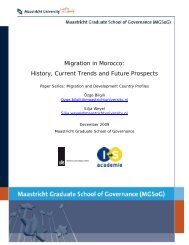Migration in Burundi: History, Current Trends and Future - MGSoG ...
Migration in Burundi: History, Current Trends and Future - MGSoG ...
Migration in Burundi: History, Current Trends and Future - MGSoG ...
You also want an ePaper? Increase the reach of your titles
YUMPU automatically turns print PDFs into web optimized ePapers that Google loves.
Coherence for Development (PCD) <strong>in</strong> the migration area. In this way the EU is also act<strong>in</strong>g<br />
on its commitments undertaken <strong>in</strong> the 2005 EU Consensus on Development by <strong>in</strong>clud<strong>in</strong>g<br />
migration issues <strong>in</strong> the political dialogue, ma<strong>in</strong>stream<strong>in</strong>g migration <strong>in</strong>to development<br />
cooperation, <strong>and</strong> creat<strong>in</strong>g synergies between migration <strong>and</strong> development policy. The EU<br />
policy <strong>in</strong> this context has ramifications for <strong>Burundi</strong>, especially <strong>in</strong> the area of the Blue Card<br />
Policy <strong>and</strong> focus on <strong>in</strong>itiatives such as return or circular migration 50 to address the problems<br />
of bra<strong>in</strong> dra<strong>in</strong> <strong>in</strong> the develop<strong>in</strong>g countries.<br />
Without its own national policies <strong>and</strong> programmes, <strong>Burundi</strong> is likely to face major<br />
challenges <strong>in</strong> terms of deal<strong>in</strong>g with migration issues. Worse still, it will miss out on the<br />
global <strong>and</strong> regional partnerships through which <strong>in</strong>ternational processes <strong>and</strong> policies such as<br />
the EU’s Global Approach are implemented. Furthermore, the development <strong>and</strong><br />
implementation of the EU migration policy cut across a number of adm<strong>in</strong>istrative areas at<br />
national <strong>and</strong> EU-level <strong>in</strong>clud<strong>in</strong>g at the <strong>in</strong>terior, justice, economics, <strong>and</strong> foreign affairs levels.<br />
It is also regulated under very different legal frameworks at national <strong>and</strong> EU level. These<br />
frameworks will directly impact <strong>Burundi</strong>ans liv<strong>in</strong>g <strong>in</strong> different EU countries <strong>in</strong> terms of<br />
entry <strong>and</strong> mobility. Other <strong>in</strong>itiatives <strong>and</strong> policies that can impact <strong>Burundi</strong> are the EU’s<br />
Directive on Common St<strong>and</strong>ards <strong>and</strong> Procedures <strong>in</strong> Member States for Return<strong>in</strong>g Illegally-<br />
Stay<strong>in</strong>g Third Country Nationals (‘Return Directive’) 51 , the EU’s support for the<br />
establishment of an African Remittances Institute, facilitation of EU-wide Diaspora<br />
networks, <strong>and</strong> the Economic Partnership Agreement (EPA).<br />
<strong>Burundi</strong> is also covered by the partnership dialogue between the EU <strong>and</strong> the AU<br />
under the Jo<strong>in</strong>t African EU Strategy (JAES) 52 <strong>in</strong> addition to already-exist<strong>in</strong>g frameworks<br />
for dialogue such as articles 8 <strong>and</strong> 13 of the Cotonou Agreement. 53 These are dialogue<br />
processes that will also impact migration <strong>and</strong> development issues with<strong>in</strong> <strong>Burundi</strong> due to<br />
their regional coverage <strong>and</strong> likely impact through implementation <strong>in</strong> countries that<br />
neighbour <strong>Burundi</strong>.<br />
50 The EU def<strong>in</strong>es circular migration as ‘a form of migration that is managed <strong>in</strong> a way allow<strong>in</strong>g some degree<br />
of legal mobility back <strong>and</strong> forth between two countries’<br />
51 Council of the European Union (2008). Directive of the European Parliament <strong>and</strong> the on common st<strong>and</strong>ards <strong>and</strong><br />
procedures <strong>in</strong> Member States for return<strong>in</strong>g illegally stay<strong>in</strong>g third country nationals. http://eurlex.europa.eu/LexUriServ/LexUriServ.do?uri=OJ:L:2008:348:0098:0107:EN:PDF<br />
52 The Jo<strong>in</strong>t Africa-EU Strategy (JAES) is an overarch<strong>in</strong>g policy framework between the AU <strong>and</strong> the EU<br />
with the aim of establish<strong>in</strong>g a “political partnership” between two Unions <strong>and</strong> to support the pan-African<br />
<strong>in</strong>tegration process, amongst others through the consolidation of the African architecture at cont<strong>in</strong>ental<br />
level.<br />
53 The Cotonou Partnership Agreement, concluded <strong>in</strong> 2000 <strong>and</strong> revised <strong>in</strong> 2005, 53 is part of a longst<strong>and</strong><strong>in</strong>g<br />
development cooperation relationship between the European Union <strong>and</strong> countries <strong>in</strong> Africa, the Caribbean<br />
<strong>and</strong> the Pacific, collectively known as the ACP Group (For details see DPIR, _ECDPM reports available at<br />
www.ecdpm.org)<br />
53



